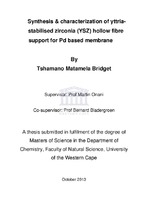Synthesis & characterization of yttria-stabilised zirconia (YSZ) hollow fibre support for Pd based membrane
Abstract
Inorganic based membranes which have a symmetric/asymmetric structure have been produced using an immersion induced phase inversion and sintering method. An organic binder solution (dope) containing yttria-stabilised zirconium (YSZ) particles is spun through a triple orifice spinneret to form a hollow fibre precursor, which is then sintered at elevated temperatures to form a ceramic support. The phase inversion process for the formation of hollow fibre membranes was studied in order to produce the best morphological structure/support for palladium based membranes. The spinning parameters, particle size, non-solvent concentration, internal coagulant as well as the calcination temperature were investigated in order to determine the optimum values. Sintering temperature was also investigated, which would yield a sponge-like structure with an optimized permeability, while retaining a smooth outer surface. The supports produced by phase inversion were characterized in terms of dimension by mercury porosimetry, compressed air permeability, Surface Electron Microscopy (SEM) and Atomic Force Microscopy (AFM). The morphology of the produced ceramic support showed either dense or porous characteristics governed by the dynamics of the phase inversion process.
The particle size of YSZ was examined in order to decrease the amount of agglomerates in the spinning suspension. Zetasizer tests indicated that at 15 minutes, the ultrasonic bath effectively homogenised the YSZ particles and prohibited soft agglomerates from reforming in the spinning suspension. In this study, an increase in air gap had no noticeable effect on the finger like voids but it had a considerable effect on both the inner diameter (ID) and outer diameter (OD) of the green fibres, while an increase in bore liquid flow rate and extrusion pressure promoted viscous fingering and significant effect on the ID and OD of the fibres, respectively. There was a decrease in porosity and permeability with increasing sintering temperature, addition of water concentration in the spinning suspension and varying N-methylpyrrolidone (NMP) aqueous solution of the internal coagulant. The amount of YSZ added to the starting suspension influenced the properties of the support structure. Viscous deformation was observed for dope with lower particle loading thus resulted in the formation of cracks and defects during sintering.

